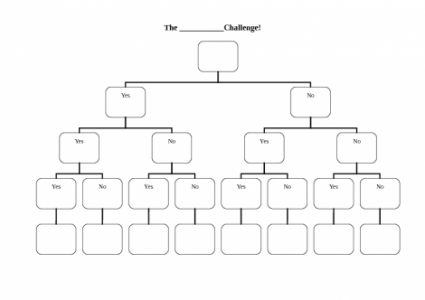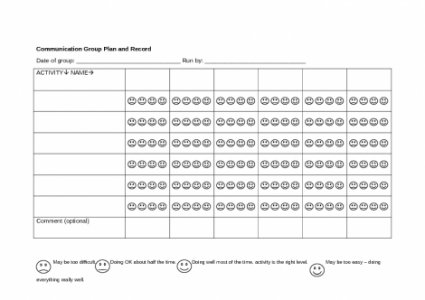Search
User login
Topic “Adult”
Adults - for those over 16 years
use switches to turn something on or off
| Activity/strategy name and materials required | How to do the activity | Key principles for doing the activity and comments |
|---|---|---|
| Keeping cool: learning to sustain an action Fan, (with optional ribbons attached) Mains switch control box | Configure the controller so that the fan is on as long as the switch is held down. Hold down the switch and let the child/adult feel the breeze. Let them do the same. | The child/adult should experience holding down the switch and feeling the breeze. On release the breeze stops. State, "On" and "Off" as you and the child/adult press and release the switch. |
| Learning to use a switch to turn a device on Fan (as above) | As either of you press the switch say, "on." When it stops say "off." Show them the effect of the breeze, blowing your hair or rubbing your arms because it is cold. | |
| Switching a device on and off (Do this in a subsequent session after the child/adult has understood the process in the above activity). A device to control, for example: fan toy computer monitor bubble machine | Let the child/adult turn the fan on and off modelling the vocabulary as you go. Reinforce this learning with different devices at different times and places. |
Make a choice using two switches
| Activity/strategy name and materials required | How to do the activity | Key principles for doing the activity and comments |
|---|---|---|
| Establishing motivators Items/activities the student may be interested in. Items/short activities the student is not interested in. |
| Don't use two things which are motivating for the student as you won't be able to tell whether they've succeeded in expressing a choice or not. |
| Establishing the switches to use Appropriate switches to use Typically you might start off with a couple of large recordable buttons (for example "Big Macs". You may have already established this with single switch work and established that they can make something happen with a single switch). | You may need to work with an occupational therapist to establish what type of switch a student can use - particularly if they have complex physical difficulties. | |
| Making choices Pair of switches Motivating and un-motivating items/activities (see the activity "establishing motivators" above) | If they don't press a switch you may need to:
Consistency of pressing Do they appear to be pressing one switch more than another, or do they appear to be choosing the switch randomly? Swapping the switches around from time to time will help you to know this. If they aren't consistent, you could try making the switches more different, for example:
You could also try:
|
Today arrow
Picture:

Picture description:
Arrow to indicate today on a timetable.
Common irregular past tense verbs
These can be used with activities sheets from www.commtap.org including:
- make phrases in past tense using irregular verbs 1
- make phrases in past tense using irregular verbs 2
Some common irregular past tense verbs for use in the above activities
See below if you are not sure what an irregular past tense verb is.
Common irregular past tense verbs
Created 15 May 2012; updated 6 December 2021.
Blank 3 question challenge
Template for creating questions using a flowchart: see https://en.commtap.org/language-communication/develop-question-skills for ideas as to how you could use this.
Created 15 May 2012; updated 16 July 2015.
Symbols - overview and sources
Symbols, communication symbols or picture symbols, are a powerful and systematic support for communication.
Description
Communication symbols are sets of images which represent words and concepts in a language in a consistent way. They are designed for use with people having difficulties accessing text and for those with communication difficulties.
They can be used with:
Prepositions
Prepositions are words which show the relationship between a noun (e.g. "cat") or a pronoun (e.g. "she") and other words in the sentence. For example, "My cat is on the table", "I went with Mike to the cinema". Prepositions can indicate relationships in time and position as well as other types of relationships. Information about prepositions (about.com).
Smiley face group progress sheet
Quick therapy/lesson evaluation sheet - using a rating scale of four smiley faces.
The idea is for the child/person to evaluate themselves in terms of how well they were able to do the activity. This helps the person running the activity to select harder or easier activities as time progresses - keeping them at a level where there is generally a high degree of success.
Created 16 February 2012; updated 16 July 2015.
Auditory discrimination of minimal pairs
| Activity/strategy name and materials required | How to do the activity | Key principles for doing the activity and comments |
|---|---|---|
| Main instructions Pictures of minimal pair words (e.g. key/tea) - photocopy them on to card (e.g. 6 of each word) so that you can't see through the card. | 1. Put one of each picture (e.g. key and tea) on the table, face up. 2. Mix up the rest of the pictures and put them in a pile face down. 3. Take one picture from the pile, don't let the person see it! 4. Say what is on the picture (e.g. key). 5. Make sure you present the pictures in a random order so that the person can't predict what's coming next. 6. The person has to find the appropriate picture on the table. | These are the main instructions for the activities. Use this with the games below. |
| Lotto game Lotto boards (4 pictures to a board. Use pairs of words from the list above, but do not put both words of a pair on the same board) Corresponding picture cards |
Make a choice between snacks
| Activity/strategy name and materials required | How to do the activity | Key principles for doing the activity and comments |
|---|---|---|
| Snacks A small choice of snack items to choose from - in small pieces - for example banana, apple, orange, crisps (the idea of having the items in small pieces is that it gives lots of opportunities to practice the request); Something uninteresting - e.g. a piece of paper; Pictures of the food items. |
| Key strategies - you may need to come back to these as and when necessary: Introduce each food item; Check which ones the people are interested in; Demonstrate the asking for and getting of an item - e.g. with another member of staff; Wait - give time for the person to respond or initiate; Offer a "forced alternative", e.g. "apple or orange?" - swap around the order in which you give the alternatives to check that the person is not just saying the last thing you say; Make it difficult for the person to communicate by pointing by having the choices close together and out of reach - so if they point you actually don't know which one they pointed to; Be sensitive to if the person is getting frustrated - think of ways to help them get it right first time - e.g. by reducing the choice down to one item (temporarily). Using forced alternatives: Always give the person the thing they said/signed for. If they are having difficulties with this - for example they always say the last thing in the alternative, try the following: Have one of the forced alternatives being something uninteresting (e.g. the piece of paper); Have the last alternative as something the person doesn't want (if the person always says the last thing); Give more emphasis to the desired item, e.g. "Banana or paper?", you could also try only signing the desired item. Over time, reduce the difference in emphasis. Improving clarity Sometimes the person may say/sign what they want, but you don't feel it is clear enough (perhaps you can understand it in this context but might not be able to in another situation). To try and improve this, you can try: Saying 'pardon?' or something equivalent; Look confused and say, for example '(Do you mean) apple or banana?' (saying and signing these) - this will often encourage the person to produce a clearer version; Simply re-inforce with the clear version, e.g. you say "Oh, banana" (saying and signing it then passing it over); Try to avoid simply asking the someone to repeat after you as there is no communication and it's not a natural way to communicate - by asking someone to repeat you have shown them that you have understood, and so this is now a different repetition activity (and perhaps a bit insulting!) - it also has the danger that it could reduce the accuracy of what they originally said or signed as they didn't get a direct result from this. |
Request a desired item
| Activity/strategy name and materials required | How to do the activity | Key principles for doing the activity and comments |
|---|---|---|
| Snack time
|
See the comments on the right as to how to respond to some typical situations. | What to do in common scenarios The person points at or tries to take the item. Hold or place the items in such a way that they can't easily take them and so that even if they point it is not clear which one they are choosing (once you know - and the person knows you know - which one they want simply now asking them to repeat what you had hoped they would have requested is much less powerful for learning). The person always asks for the last thing you said (e.g. always asking for a crisp): Try reversing the order of the choice you give them; If they don't seem to care which one you give them, give them a choice of a desirable item and a boring item - saying the boring item last - then respond to their request for the boring item. To stop frustration, you might need to quickly follow this up with another go where you only offer them one item (the desirable item); Encourage them to point to a picture to show you which one they want - then reinforce this by signing and saying the word. General strategies Model the asking and requesting with someone (e.g. other staff) to show what you are hoping people to do. |
Support Commtap to keep it online
Thank you for visiting Commtap.
Please read this message as it is extremely important.
- Visitor donations mean we can continue to host over 1,000 free activities to support speech, language, and communication development.
- Visitor donations mean we can continue to provide free resources to address a wide range of communication needs, including limited speech or language, interaction challenges, and needs associated with conditions such as developmental language disorder, autism, and cerebral palsy.
- Visitor donations mean we can continue to provide resources to support the work of speech and language therapists, teachers, teaching assistants, parents, and carers.
- Visitor donations mean we can continue to provide the free key word sign dictionary (bks.org.uk) which has over 2,000 Makaton and Signalong signs.
We know that not everyone is able to afford to pay to access these resources, however, if you can, please make a donation to keep the site going.
Thank you
Google ads on this page are provided by Google Adsense - and their presence does not imply any endorsement by Commtap. Report a problem with an ad on this page. Log in (for free) to avoid seeing Google ads.






